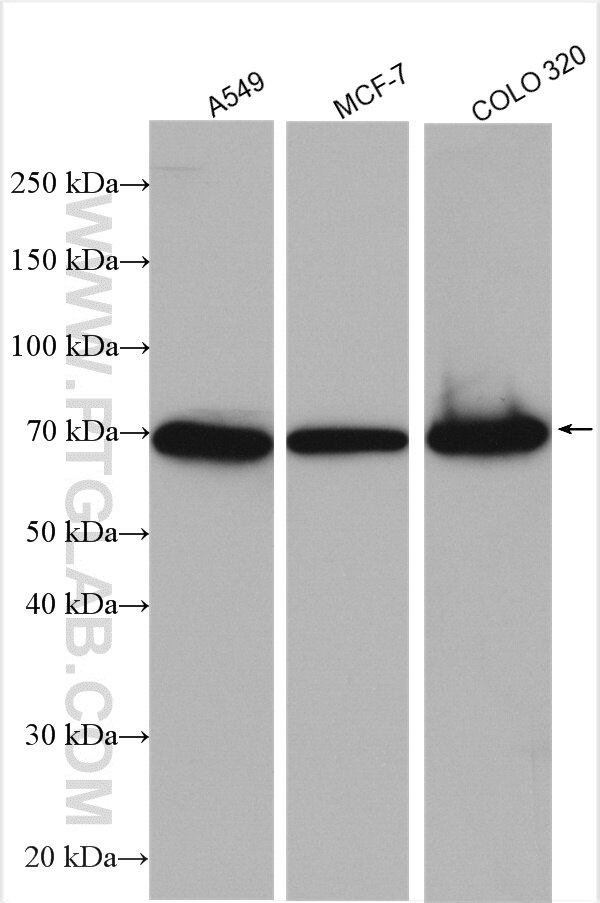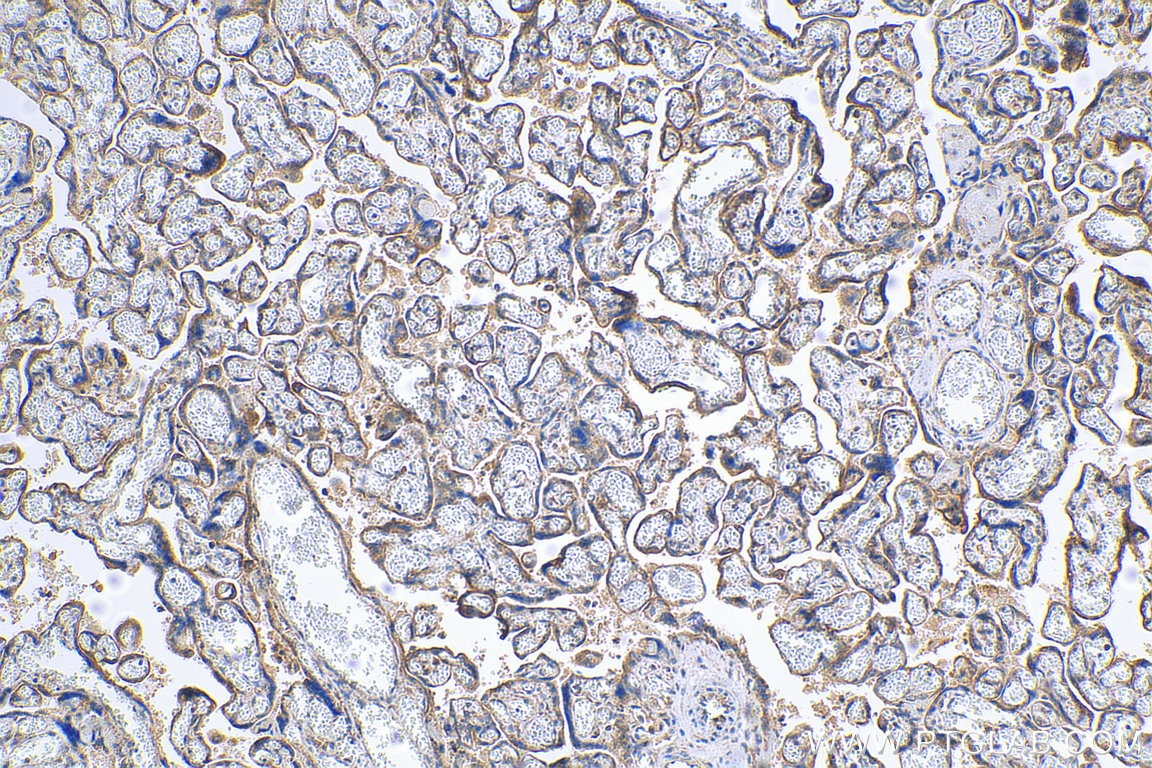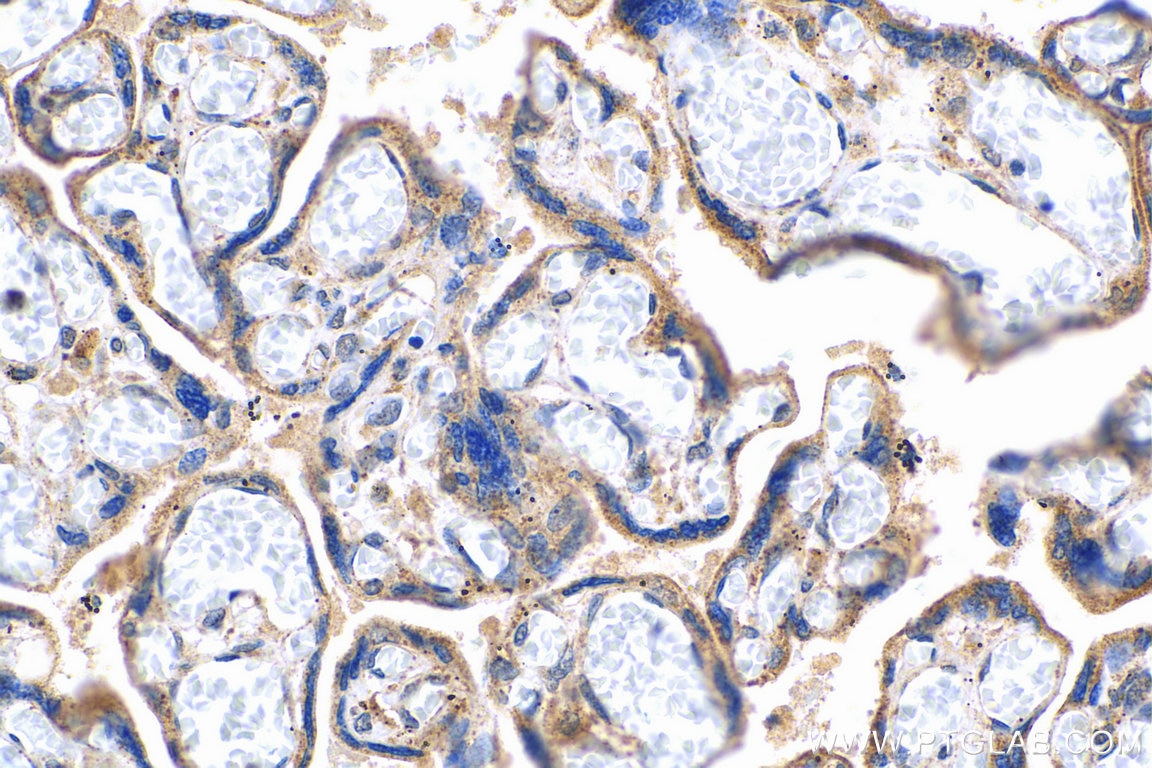TGFBR2 Polyklonaler Antikörper
TGFBR2 Polyklonal Antikörper für WB, IHC, ELISA
Wirt / Isotyp
Kaninchen / IgG
Getestete Reaktivität
human und mehr (2)
Anwendung
WB, IHC, ELISA
Konjugation
Unkonjugiert
Kat-Nr. : 27212-1-AP
Synonyme
Geprüfte Anwendungen
| Erfolgreiche Detektion in WB | A549-Zellen, MCF-7-Zellen |
| Erfolgreiche Detektion in IHC | humanes Plazenta-Gewebe Hinweis: Antigendemaskierung mit TE-Puffer pH 9,0 empfohlen. (*) Wahlweise kann die Antigendemaskierung auch mit Citratpuffer pH 6,0 erfolgen. |
Empfohlene Verdünnung
| Anwendung | Verdünnung |
|---|---|
| Western Blot (WB) | WB : 1:500-1:2000 |
| Immunhistochemie (IHC) | IHC : 1:50-1:500 |
| It is recommended that this reagent should be titrated in each testing system to obtain optimal results. | |
| Sample-dependent, check data in validation data gallery | |
Veröffentlichte Anwendungen
| WB | See 10 publications below |
| IHC | See 1 publications below |
Produktinformation
27212-1-AP bindet in WB, IHC, ELISA TGFBR2 und zeigt Reaktivität mit human
| Getestete Reaktivität | human |
| In Publikationen genannte Reaktivität | human, Maus, Ratte |
| Wirt / Isotyp | Kaninchen / IgG |
| Klonalität | Polyklonal |
| Typ | Antikörper |
| Immunogen | TGFBR2 fusion protein Ag25767 |
| Vollständiger Name | transforming growth factor, beta receptor II (70/80kDa) |
| Berechnetes Molekulargewicht | 65 kDa |
| Beobachtetes Molekulargewicht | 65-80 kDa |
| GenBank-Zugangsnummer | BC040499 |
| Gene symbol | TGFBR2 |
| Gene ID (NCBI) | 7048 |
| Konjugation | Unkonjugiert |
| Form | Liquid |
| Reinigungsmethode | Antigen-Affinitätsreinigung |
| Lagerungspuffer | PBS with 0.02% sodium azide and 50% glycerol |
| Lagerungsbedingungen | Bei -20°C lagern. Nach dem Versand ein Jahr lang stabil Aliquotieren ist bei -20oC Lagerung nicht notwendig. 20ul Größen enthalten 0,1% BSA. |
Hintergrundinformationen
TGF beta Receptor II (TGFBR2) is a member of the transforming growth factor-β (TGF-β) superfamily, which are critical regulators of cell proliferation and differentiation, developmental patterning and morphogenesis, and disease pathogenesis (PMID: 10974075). TGFBR2 result in both SMAD4-dependent constraint of proliferation and SMAD4-independent activation of apoptosis (PMID: 29396446). The calculated molecular weight of TGFBR2 is 65 kDa. It has some isoforms with the molecular weight of 70-80 kDa and ~90 kDa after glycosylated.
Protokolle
| PRODUKTSPEZIFISCHE PROTOKOLLE | |
|---|---|
| WB protocol for TGFBR2 antibody 27212-1-AP | Protokoll herunterladen |
| IHC protocol for TGFBR2 antibody 27212-1-AP | Protokoll herunterladenl |
| STANDARD-PROTOKOLLE | |
|---|---|
| Klicken Sie hier, um unsere Standardprotokolle anzuzeigen |
Publikationen
| Species | Application | Title |
|---|---|---|
Biochim Biophys Acta Mol Cell Res YWK-II/APLP2 inhibits TGF-β signaling by interfering with the TGFBR2-Hsp90 interaction | ||
Cell Commun Signal The activation of PPARγ enhances Treg responses through up-regulating CD36/CPT1-mediated fatty acid oxidation and subsequent N-glycan branching of TβRII/IL-2Rα. | ||
Reprod Sci Maternal Perinatal Exposure to Dibutyl Phthalate Promotes Ovarian Dysfunction in Adult Female Offspring via Downregulation of TGF-β2 and TGF-β3. | ||
Cell Chem Biol Therapeutic potency of compound RMY-205 for pulmonary fibrosis induced by SARS-CoV-2 nucleocapsid protein | ||
Acta Histochem Inhibition of glutamine transporter ASCT2 mitigates bleomycin-induced pulmonary fibrosis in mice |




